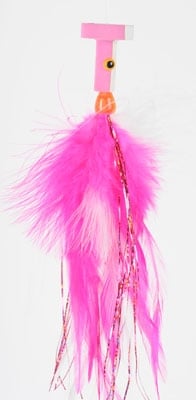
The use of tube flies is hardly a new tactic. As a matter of fact, it’s been said that Native Americans used to fix animal fur and feathers to hollow quills to catch salmon. As primitive as that may have been, the idea is still in use today. I wouldn’t necessarily say that offshore fly anglers use tube flies exclusively, but I would say that, by and large, tube flies are the most common type used by those who target billfish and other pelagic species.
Before my first billfishing endeavor, I had never used a tube fly and didn’t intend to do so. I just never saw any real advantage. Before my trip, I sat at my vise and began tying what I thought would make good billfish patterns. After showing them to a few veterans of the game, I was told by all that they were too small. So I tied bigger ones on larger hooks and showed them off again, and I was told that the hooks were too big and that I should really have a tandem- hook rig.
The question is: How are you supposed to tie (or rig) large flies on smaller hooks? The answer is to learn how to rig tube flies. Once you fish with them a few times, you will find many advantages and probably won’t want to head offshore (or inshore in some cases) without at least a few on hand. Here are some noteworthy pluses that will hopefully encourage you to try them out for yourself.
1. Versatility – When you’re using a traditional fly with all the materials tied directly to the hook shank, that’s it – that’s your fly. Because tube flies are tied to a plastic tube and aren’t tied to the hook at all, you can use the fly in a variety of setups. For example, you can use the same fly on a single hook rig or a tandem rig. Also, you can use the same fly as either a stand-alone fly, or you can add a popper or a bubbler cone to fit the situation. At the end of the day, it’s all the same fly.
2. Control – Even if you don’t tie flies at all, you still have complete control over what size hook(s) you use. For example: Marlin obviously prefer larger baits and if you want to tie (or buy) a fly to imitate a large baitfish, the hook shank will have to be huge to accommodate the length and quantity of material required to give the fly a large profile. Using a tube fly allows you to use oversize fly patterns with whatever style/size of hook(s) you want. On your next trip, say you want to scale down the size of the hook or use a different style – you don’t have to buy a new fly. All you have to do is rig your leader with the hooks you want, slide the fly on and you are ready to fish.
3. Lack of Leverage – When a big pelagic gets hooked, it’s going to shake its head like mad. If you were to use a large fly tied in a traditional style, the shank and size of the hook would have to be large (as mentioned previously). A side effect of using a longer-shank hook is that it gives the fish a leverage point against the hook. For example: If the eye of the hook gets wedged inside the fish’s mouth and the shank is 3 inches long, it’s far easier for the fish to shake its head or bite down in a way that the hook will pop out than if you were using a shorter-shank hook. In other words, long shank hooks have a tendency to work like a hook remover if they are positioned at certain angles.
4. Slide Factor – When an angler is putting tension on a fish that’s been hooked with a tube fly, the fly will actually slide up the leader. Because of the knots used in offshore fly fishing, the fly won’t slide far. However, it will often slide all the way up to the knot that connects your class tippet to your shock tippet. Even if it only slides up 10 inches, that’s enough to get the fly out of the fish’s face, making for one less object in the business end of the fight. Also, since the fly isn’t in the fish’s face, it’s not getting chewed which will add life to your fly.
5. Hook Help – No matter the manufacturer, hooks get damaged. I’ve had hooks break or bend out on several occasions, and I’ve even had cases in which the point rolls over. When any of this happens, the fly is useless if it’s conventionally tied. If this happens on a tube setup, all you have to do is swap out your tippet with a pre-tied tippet, slide the same tube fly on, tie on a new hook, and you are back in business.
Rigging Tips
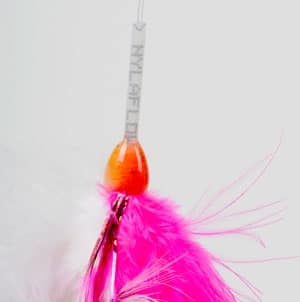
If you plan on tying your own tube patterns, you will need a tube fly attachment for your vise. There are many manufacturers that produce them, they aren’t expensive, and they are easy to use.
Basically, to rig a tube fly, you simply construct your leader the way you normally would until you get to your shock tippet. When you’re rigging your shock tippet for a tube fly, there are many ways to go about it. The most common method is to rig your hooks using a snell to fix them to the leader. There are other methods such as using small crimps and or loop knots, but the most effective is definitely the snell, since it allows you to position the hooks in a way that will hook the fish easier and more efficiently. Ideally, if you are rigging a tandem setup, you want the lead hook to run parallel to the water surface and you want your trailer hook to run perpendicular to that.
So really, if you can snell, you can rig a tube fly. Follow the link below to learn how.
If you followed the illustrations, you probably figured out that the snell is nothing to be afraid of – it’s really not that difficult of a knot to tie.
If you plan on rigging tandem setups, there are two tricky aspects. The first is learning how much slack you need to tie the trailing hook and still retain an IGFA-legal shock tippet. The second is learning how to position the hooks in the parallel and perpendicular style mentioned.
The best advice is to find some old monofilament and sit down with a couple of hooks and experiment. Different people require different lengths to tie knots correctly so that part is dependent on what you are comfortable with. As far as positioning the hooks correctly, it’s not as difficult as it seems. You just need to be conscious of where the shank on the trailer hooks in relation the lead hook before you cinch the knot. It will take a few tries to tie them properly on a consistent basis, but after a few practice runs, you will find that it’s not that tricky after all, and you will have a new and effective rig in your arsenal.
For Custom Pre-rigged tube flies contact: www.camsigler.com or www.saltwaterflytyers.com
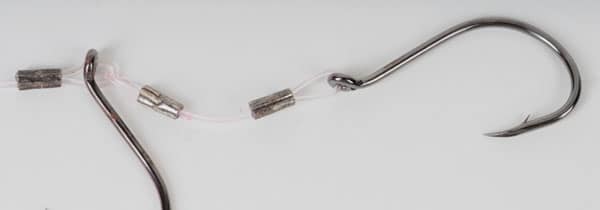
For a quick rig, crimps will work in a pinch for tube flies
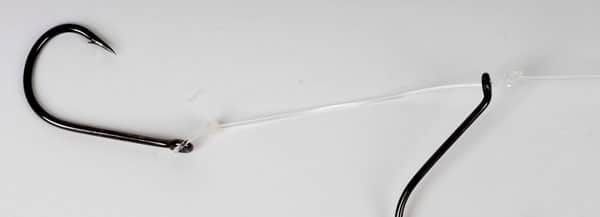
You can rig tube flies with other knots besides the snell. However, if you do, it’s highly recommended that you use loop knots.
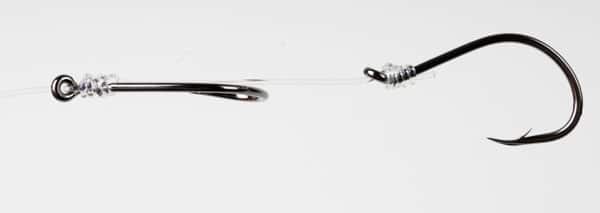
Rigged correctly, your tandem setup for a tube fly should look like this. the lead hook should run parallel to the water surface and the trailer perpendicular to it.









